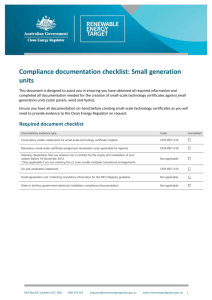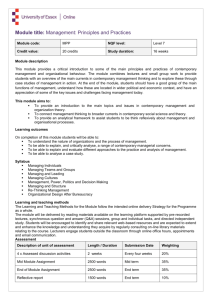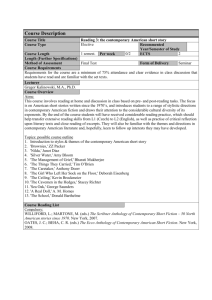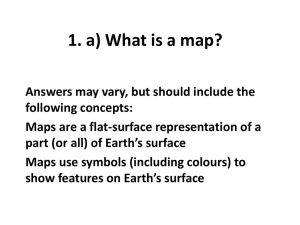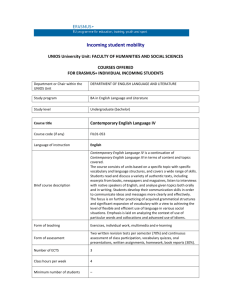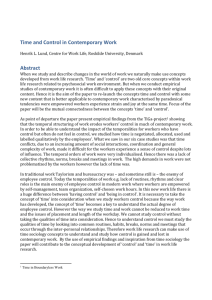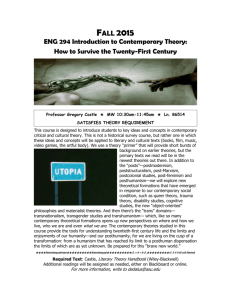PRESS RELEASE Public Assets: small
advertisement
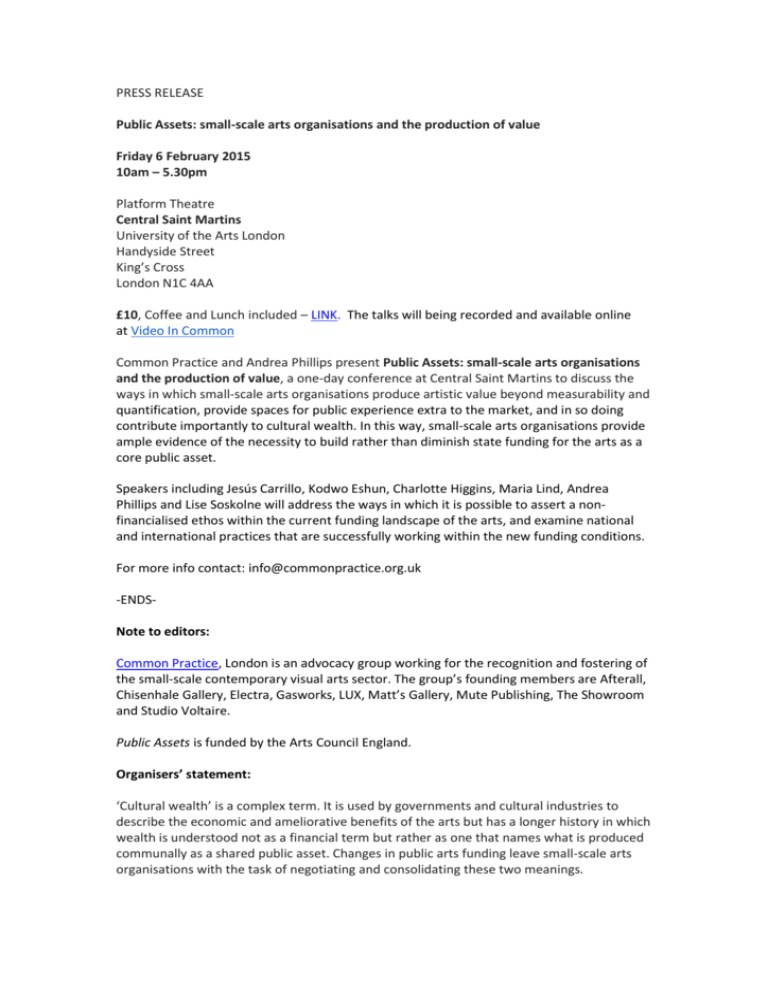
PRESS RELEASE Public Assets: small-scale arts organisations and the production of value Friday 6 February 2015 10am – 5.30pm Platform Theatre Central Saint Martins University of the Arts London Handyside Street King’s Cross London N1C 4AA £10, Coffee and Lunch included – LINK. The talks will being recorded and available online at Video In Common Common Practice and Andrea Phillips present Public Assets: small-scale arts organisations and the production of value, a one-day conference at Central Saint Martins to discuss the ways in which small-scale arts organisations produce artistic value beyond measurability and quantification, provide spaces for public experience extra to the market, and in so doing contribute importantly to cultural wealth. In this way, small-scale arts organisations provide ample evidence of the necessity to build rather than diminish state funding for the arts as a core public asset. Speakers including Jesús Carrillo, Kodwo Eshun, Charlotte Higgins, Maria Lind, Andrea Phillips and Lise Soskolne will address the ways in which it is possible to assert a nonfinancialised ethos within the current funding landscape of the arts, and examine national and international practices that are successfully working within the new funding conditions. For more info contact: info@commonpractice.org.uk -ENDSNote to editors: Common Practice, London is an advocacy group working for the recognition and fostering of the small-scale contemporary visual arts sector. The group’s founding members are Afterall, Chisenhale Gallery, Electra, Gasworks, LUX, Matt’s Gallery, Mute Publishing, The Showroom and Studio Voltaire. Public Assets is funded by the Arts Council England. Organisers’ statement: ‘Cultural wealth’ is a complex term. It is used by governments and cultural industries to describe the economic and ameliorative benefits of the arts but has a longer history in which wealth is understood not as a financial term but rather as one that names what is produced communally as a shared public asset. Changes in public arts funding leave small-scale arts organisations with the task of negotiating and consolidating these two meanings. Over the past two decades public funding for the arts in the UK has become dominated by cultural entrepreneurial initiatives and schemes designed to ensure that arts organisations develop profitable relations with private funders and foundations. Like their larger cousins, small and medium-scale arts institutions in the UK are increasingly under pressure to develop private income streams in order to survive; without the development budgets and administrative infrastructures through which larger arts organisations negotiate the shifting financial landscape, small-scale institutions find this extremely difficult and time-consuming, even where there is a willingness on the part of staff and director to engage with the necessities of entrepreneurialism. Such a situation is made more complex by the competition that emerges between arts institutions, as each chases the same sponsors and patrons. As Common Practice has already proved in its report Size Matters, it is also made more complex by the lack of financial recognition of the deferred value produced by smallscale institutions, as they support artists and curators at the beginning of their careers. The naturalisation of this process has become endemic within the arts at all scales in the UK as elsewhere, but it is within the small-scale arts sector that the values of supporting experimental and often non-commodifiable artistic practice is developed, promoted and sustained by curators and administrators. These values are difficult to maintain at the same time as holding on to the diminishing amount of funding available within the culture of financialisation. It is not just the lack of administrative time that is at stake as small-scale arts institutions shift their practices within this financial ecology, it is also the ethos of production and distribution. What gets made public in these institutions is also affected by what can be funded – and what gets funded is shaped by the same feedback loop. This conference will address the ways in which it is possible to assert a non-financialised ethos within the current funding landscape of the arts, and will seek to develop a vocabulary separate to the one of instrumentalisation with which to argue for this ethos. It will examine national and international practices that are successfully working within the new funding conditions and delivering exhibitions and events that exemplify the arts institution as an essential public asset. Speakers Biographies Jesús Carrillo is a lecturer of Contemporary Art History at the Universidad Autonoma de Madrid and was Head of the Cultural Programmes Department of the Reina Sofía Museum from 2008 to 2014. He combines the analysis of contemporary culture and cultural institutions with a critical reading of historical narratives of art. He has published: Arte en la Red (Madrid: Cátedra, 2004), Naturaleza e Imperio (Madrid: 12 calles, 2004) y Tecnología e Imperio (Madrid: Nivola, 2003), and as editor: Modos de hacer: arte crítico, esfera pública y acción directa (Salamanca: Ediciones de la Universidad de Salamanca, 2001), Tendencias del Arte. Arte de Tendencias (Madrid: Cátedra, 2003), Desacuerdos: sobre arte, políticas y esfera pública en el Estado español vols 1, 2, 3 y 4 (Barcelona: Macba, 2004-2007), Douglas Crimp: Posiciones críticas (Madrid: Akal, 2005), Martha Rosler. Imágenes Públicas (Barcelona: Gustavo Gili, 2008) Kodwo Eshun is an artist and theorist. Eshun studied English Literature at University College, Oxford University and is Lecturer in Aural and Visual Cultures at Goldsmiths, University of London. In 2002, he founded The Otolith Group with Anjalika Sagar. Eshun is co-editor of The Ghosts of Songs: The Film Art of the Black Audio Film Collective, 2007, Harun Farocki: Against What? Against Whom?, 2009, The Militant Image: A Cine-Geography, 2011 and author of Dan Graham: Rock My Religion, 2012. Nominated for The Turner Prize in 2010, The Otolith Group’s work explores the potentials of liberation struggles, speculative futures and science-fictions. The Otolith Group have presented recent solo exhibitions at CASCO, Utrecht, Bergen Kunsthall, REDCAT, Los Angeles and participated in recent group exhibitions at Museum of Modern Art, New York, CCA, Singapore, Haus der Kulturen der Welt, Berlin, The Studio Museum in Harlem, Haus der Kunst, Munich and Guggenheim Museum, New York. Charlotte Higgins is the chief culture writer of the Guardian and a member of its editorial board. This New Noise, a book based on her nine-partseries of essays on the BBC, is to be published by Guardian-Faber in 2015. Higgins began her career in journalism on Vogue magazine in 1995 and moved to the Guardian in 1997, for which she has served as classical music editor and arts correspondent. A classicist by education, she is the author of three books on aspects of the ancient world. The most recent, UnderAnother Sky: Journeys in Roman Britain (Vintage, 2014), was shortlisted for the Samuel Johnson prize for non-fiction, the Thwaites Wainwright prize for nature writing, the Dolman travel-writing prize and the Hessell-Tiltman history prize. In 2010, she won the Classical Association prize for her books and journalism. She has served as a judge for the Art Fund museums prize, the Contemporary Art Society award, and the Royal Philharmonic Society awards. She is an associate member of the Centrefor the Study of Greek and Roman Antiquity at Corpus Christi College, Oxford and is on the board of the HenryBarber Trust. She is a keen amateur violinist. Maria Lind is Director of the Tensta Konsthall and an independent curator and writer. She was the director of the graduate program at the Center for Curatorial Studies, Bard College from 2008–10. Before that, she was director of lASPIS in Stockholm (2005–07) and Director of the Munich Kunstverein (2002–04). Previous to that she was curator at Moderna Museet in Stockholm (from 1997–2001) and in 1998 was co-curator of Manifesta 2, Europe’s nomadic biennial of contemporary art. Lind was the 2009 recipient of the Walter Hopps Award for Curatorial Achievement. A compendium of her essays to date, Selected Maria Lind Writing, was published by Sternberg Press in 2010. Andrea Phillips is Professor of Fine Art and Director of PhD programmes in the Art Department at Goldsmiths. Andrea lectures and writes about the economic and social construction of publics within contemporary art. Recent and ongoing research projects include: Curating Architecture, a think tank and exhibition examining the role of exhibitions in the making of architecture’s social and political forms (AHRC 20072009: http://www.art.gold.ac.uk/research/archive/curating-architecture/), Actors, Agent and Attendants, a research project and set of publications that address the role of artistic and curatorial production in contemporary political milieus (in collaboration with SKOR 2009-2012: http://www.skor.nl/eng/site/item/actors-agents-and-attendants-ii-programme), co-director with Suhail Malik, Andrew Wheatley and Sarah Thelwall of the research project The Aesthetic and Economic Impact of the Art Market, an investigation into the ways in which the art market shapes artists’ careers and public exhibition (2010-ongoing), Public Alchemy, the public programme for the Istanbul Biennial 2013 (co-curated with Fulya Erdemci), Tagore, Pedagogy and Contemporary Visual Cultures (in collaboration with Grant Watson and Iniva, AHRC 2013-2014: http://art.gold.ac.uk/tagore/), How to Work Together (in collaboration with Chisenhale Gallery, Studio Voltaire and The Showroom, London 2014ongoing: http://howtoworktogether.org/). Lise Soskolne is a Canadian-born artist and Core Organizer of W.A.G.E. She has 17 years of work experience in non-profit arts presenting and development at venues in New York City that have included Anthology Film Archives, Artists Space, Diapason Gallery for Sound, Meredith Monk/The House Foundation for the Arts, Participant Inc. and Roulette Intermedium. In 2007 she founded and managed the arts component in the broader regeneration of Industry City, a 6.5-million sq ft industrial complex on the South Brooklyn waterfront. Its goal was to establish a new paradigm for industrial redevelopment that would not displace artists, workers, local residents or industry but would instead build a sustainable community of working artists in a context that integrated cultural and industrial production.
